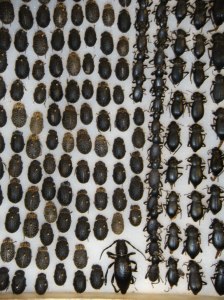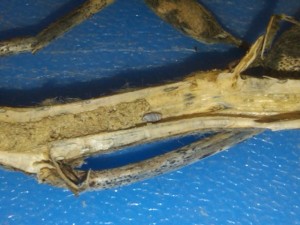One of the best things about living in Southern Idaho is the Orma J. Smith Museum of Natural

If your heart doesn’t beat a little faster when you see this sign, maybe you have a heart problem!
History on the College of Idaho Campus in Caldwell, ID. Yesterday was the museum workday, when museum volunteers get together to work in the museum. Being a museum volunteer has a many perks! First of all you get to enter through the back door (but do not forget to sign in up front)! The front of the museum is impressive, but in the back there are stacks and stacks of fossils, fishes, insects, birds, books (the herbarium is upstairs) – all the stuff that breathes life into the museum. As you walk in the back door you are greeted by the promise of discovery! It is the coolest feeling. After walking

The view as you walk in the back door – isn’t it exciting?
through the back of the museum, you come to the coffee pot, which is a good place to find the Museum Director – Bill Clark. Bill keeps his network of volunteers on interesting and useful projects (I am certain it is like herding cats), and always has time to bounce ideas off and help you even though he is busier than 10 normal folks. Next, if you are me, you check in with Al Gillogly. Al is the curator of beetles, and he is always up to something interesting. Yesterday I had my mind blown by a hymenopteran in the genus Baeus, and a very non-typical coccinellid

A field box of pitfall trap from Baja Mexcio – isn’t this cool?
and a tiny tenebrionid. George Sims had sent the Museum some Nitidula flavomaculata and Catops sp. so, I got to hone my pointing skills at the museum.
Being at the museum workday is like hanging out with the super friends. There is: Paul Castrovilla, who taught me about butterflies; Steve Bouffard, who has taught me about just about everything just by being a good role model; Mary Clark, who is busier than Bill but always makes time to answer my questions, Dave Ward, who has as his super power being about the nicest guy you will ever meet; Jim Ryan is the curator of entomology and is always up for ento-fun and knowledge, and there are all the other talented and passionate folks in other disciplines who make the Orma J. Smith Museum such a tasty stew. I drive home from the Orma J. Smith Museum not only having learned a ton about insects, but also feeling better about the human race.
The museum may gain a tiny amount of labor from my presence, but my gains are far greater. I am so grateful that Bill Clark allows me these opportunities.





